The Impact of Attachment Styles on Key Areas of Child Development
VerifiedAdded on 2023/06/14
|7
|1874
|154
Essay
AI Summary
This essay delves into the significant role attachment styles play in a child's development, particularly focusing on secure and insecure attachment patterns. It discusses methods used to identify these attachment styles, highlighting the importance of responsive and affectionate caregiving. Secure attachment fosters emotional stability, independence, and a willingness to explore, while insecure attachment can lead to anxiety and a lack of trust. The essay also analyzes the advantages and disadvantages of both attachment styles, noting that while secure attachment promotes emotional well-being, excessive parental involvement can hinder independent thinking. Conversely, insecure attachment may foster independence but can also result in lower confidence and increased stress. Ultimately, the essay concludes that secure attachment generally provides a more favorable foundation for a child's psychological and physical development, leading to greater emotional stability and creativity.
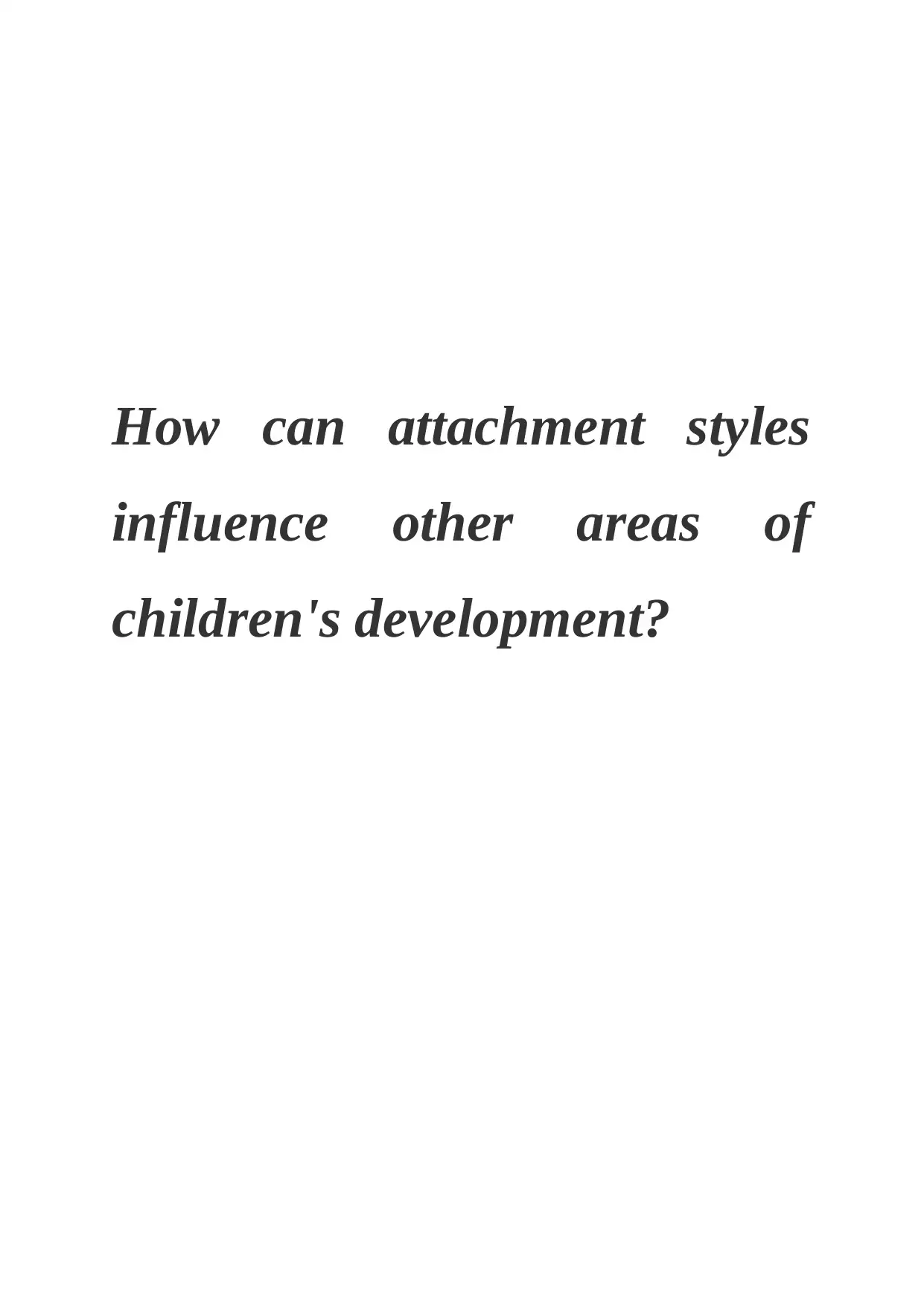
How can attachment styles
influence other areas of
children's development?
influence other areas of
children's development?
Paraphrase This Document
Need a fresh take? Get an instant paraphrase of this document with our AI Paraphraser
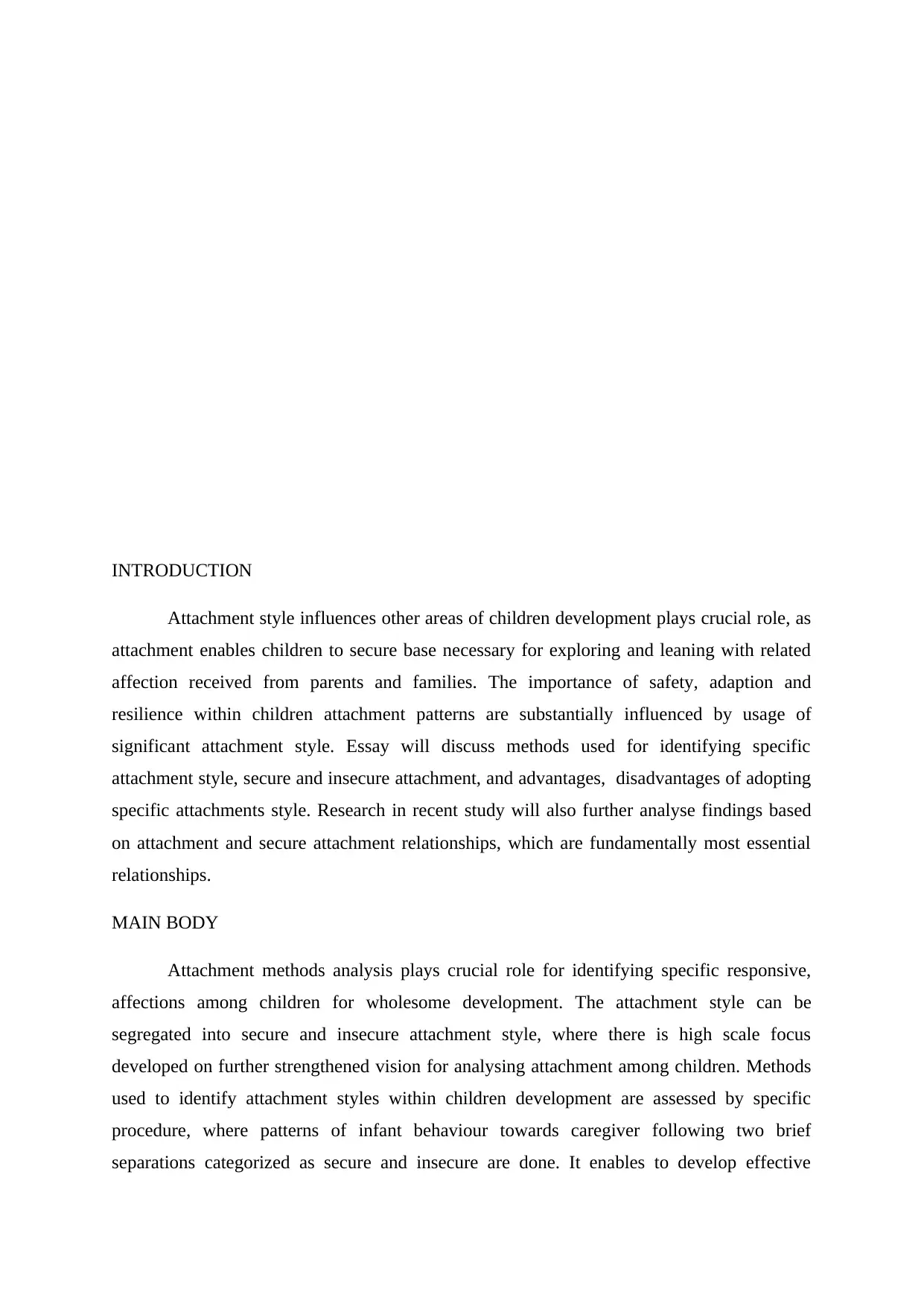
INTRODUCTION
Attachment style influences other areas of children development plays crucial role, as
attachment enables children to secure base necessary for exploring and leaning with related
affection received from parents and families. The importance of safety, adaption and
resilience within children attachment patterns are substantially influenced by usage of
significant attachment style. Essay will discuss methods used for identifying specific
attachment style, secure and insecure attachment, and advantages, disadvantages of adopting
specific attachments style. Research in recent study will also further analyse findings based
on attachment and secure attachment relationships, which are fundamentally most essential
relationships.
MAIN BODY
Attachment methods analysis plays crucial role for identifying specific responsive,
affections among children for wholesome development. The attachment style can be
segregated into secure and insecure attachment style, where there is high scale focus
developed on further strengthened vision for analysing attachment among children. Methods
used to identify attachment styles within children development are assessed by specific
procedure, where patterns of infant behaviour towards caregiver following two brief
separations categorized as secure and insecure are done. It enables to develop effective
Attachment style influences other areas of children development plays crucial role, as
attachment enables children to secure base necessary for exploring and leaning with related
affection received from parents and families. The importance of safety, adaption and
resilience within children attachment patterns are substantially influenced by usage of
significant attachment style. Essay will discuss methods used for identifying specific
attachment style, secure and insecure attachment, and advantages, disadvantages of adopting
specific attachments style. Research in recent study will also further analyse findings based
on attachment and secure attachment relationships, which are fundamentally most essential
relationships.
MAIN BODY
Attachment methods analysis plays crucial role for identifying specific responsive,
affections among children for wholesome development. The attachment style can be
segregated into secure and insecure attachment style, where there is high scale focus
developed on further strengthened vision for analysing attachment among children. Methods
used to identify attachment styles within children development are assessed by specific
procedure, where patterns of infant behaviour towards caregiver following two brief
separations categorized as secure and insecure are done. It enables to develop effective

analysis on response pattern within child, and also enhances vision for parents further timely
attention regarding various new activities. In the children development, there are two aspects
which are highly essential and are divided into secure and insecure attachment relationships
where psychology of children can be effectively analysed (Cantor and et.al,., 2021).
The children development are highly connected towards based on attachment methods
analysis, further strengthening practical working consistencies towards proper development.
Attachment method holds huge importance for strengthening wider understanding levels
among parent child relationships, analyzing specific conditions where there has to be further
improvement developed on. This signifies that major secure relationship is developed on,
between child and parent only by strengthening effective rise towards keen functional vision.
Methods analysis of attachment relationships among children, further makes vital connection
enhance for longer time period with informative consistency towards diverse functional
analysis. This enhances abilities to monitor children behaviour, signifies that major new steps
are to be developed in cline with children recent activities. This enhances mutual significant
functional maintenance and larger positive warm relationship to be developed among abilities
within children, from early childhood. Also, by determining timely analysis of secure and
unsecure relationship, children are able to develop cope up abilities towards determined new
understanding for extended time period diversely (Saracho and Evans, 2021).
The secure attachment relationship signifies that children who are securely attached
tend to have less extreme reactions to stress, are happy along with willingness to try new
things for exploring new experiences independently. The secure theory has been found to be
essentially effective for identifying positive aptitude development among children, where it
further synchronizes specific technical growth goals. Parents and caregivers ensure that
children feel secure, understood and calm enough with experience for optimal development
and better secure understanding is developed (Saracho, 2021).
. Secure attachment relationship signifies that major children development is done in
childhood period only, where further improvising goals are connected ton extended domains.
This enables emotional abilities in children to be developed diversely, and enhance further
aptitude towards strengthened for extended time period paradigms. Secure attachment builds
strong emotional understanding between child and parents, which further forms strong
connect towards various situations for extended new learning competencies. It further makes
attention regarding various new activities. In the children development, there are two aspects
which are highly essential and are divided into secure and insecure attachment relationships
where psychology of children can be effectively analysed (Cantor and et.al,., 2021).
The children development are highly connected towards based on attachment methods
analysis, further strengthening practical working consistencies towards proper development.
Attachment method holds huge importance for strengthening wider understanding levels
among parent child relationships, analyzing specific conditions where there has to be further
improvement developed on. This signifies that major secure relationship is developed on,
between child and parent only by strengthening effective rise towards keen functional vision.
Methods analysis of attachment relationships among children, further makes vital connection
enhance for longer time period with informative consistency towards diverse functional
analysis. This enhances abilities to monitor children behaviour, signifies that major new steps
are to be developed in cline with children recent activities. This enhances mutual significant
functional maintenance and larger positive warm relationship to be developed among abilities
within children, from early childhood. Also, by determining timely analysis of secure and
unsecure relationship, children are able to develop cope up abilities towards determined new
understanding for extended time period diversely (Saracho and Evans, 2021).
The secure attachment relationship signifies that children who are securely attached
tend to have less extreme reactions to stress, are happy along with willingness to try new
things for exploring new experiences independently. The secure theory has been found to be
essentially effective for identifying positive aptitude development among children, where it
further synchronizes specific technical growth goals. Parents and caregivers ensure that
children feel secure, understood and calm enough with experience for optimal development
and better secure understanding is developed (Saracho, 2021).
. Secure attachment relationship signifies that major children development is done in
childhood period only, where further improvising goals are connected ton extended domains.
This enables emotional abilities in children to be developed diversely, and enhance further
aptitude towards strengthened for extended time period paradigms. Secure attachment builds
strong emotional understanding between child and parents, which further forms strong
connect towards various situations for extended new learning competencies. It further makes
⊘ This is a preview!⊘
Do you want full access?
Subscribe today to unlock all pages.

Trusted by 1+ million students worldwide
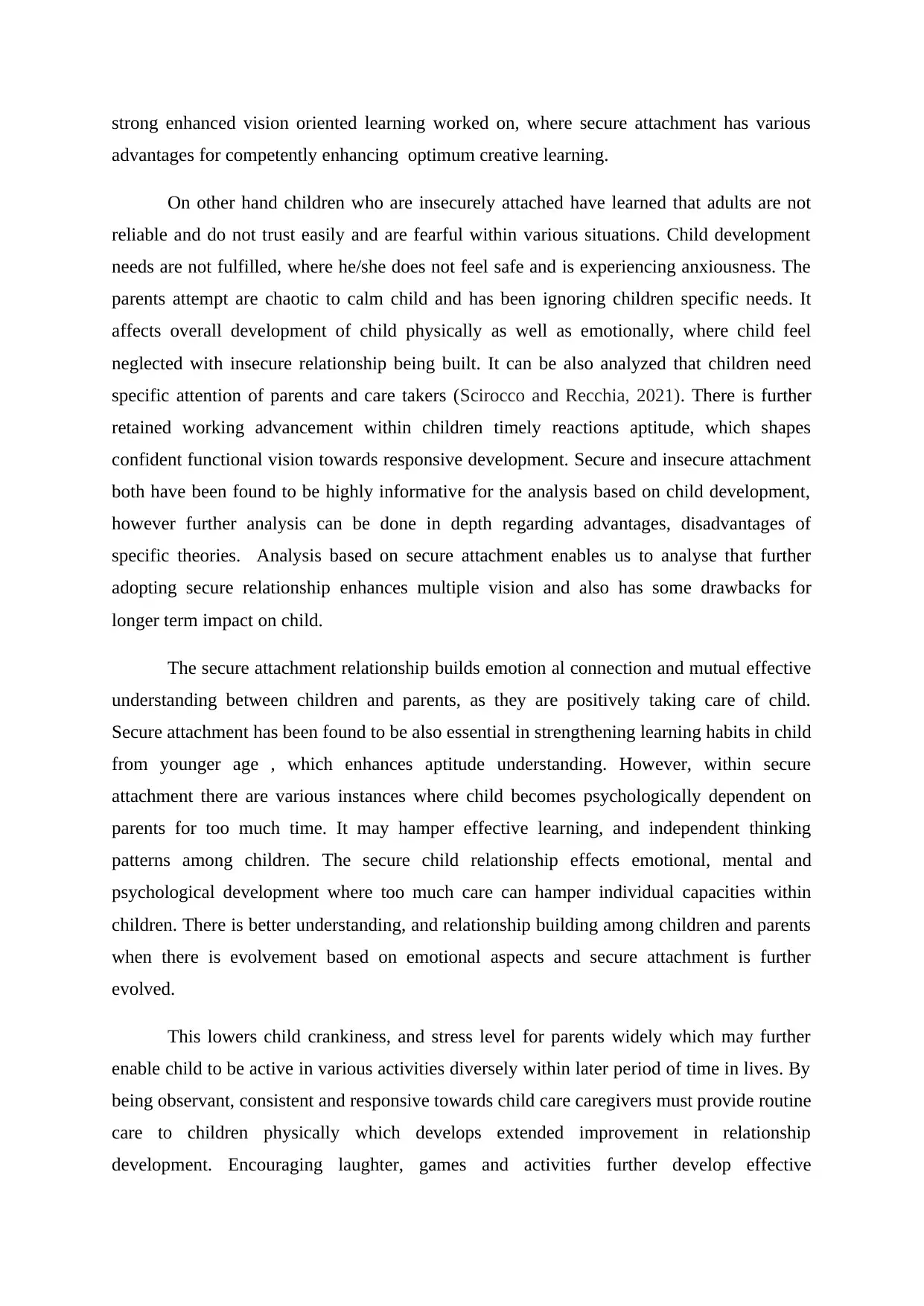
strong enhanced vision oriented learning worked on, where secure attachment has various
advantages for competently enhancing optimum creative learning.
On other hand children who are insecurely attached have learned that adults are not
reliable and do not trust easily and are fearful within various situations. Child development
needs are not fulfilled, where he/she does not feel safe and is experiencing anxiousness. The
parents attempt are chaotic to calm child and has been ignoring children specific needs. It
affects overall development of child physically as well as emotionally, where child feel
neglected with insecure relationship being built. It can be also analyzed that children need
specific attention of parents and care takers (Scirocco and Recchia, 2021). There is further
retained working advancement within children timely reactions aptitude, which shapes
confident functional vision towards responsive development. Secure and insecure attachment
both have been found to be highly informative for the analysis based on child development,
however further analysis can be done in depth regarding advantages, disadvantages of
specific theories. Analysis based on secure attachment enables us to analyse that further
adopting secure relationship enhances multiple vision and also has some drawbacks for
longer term impact on child.
The secure attachment relationship builds emotion al connection and mutual effective
understanding between children and parents, as they are positively taking care of child.
Secure attachment has been found to be also essential in strengthening learning habits in child
from younger age , which enhances aptitude understanding. However, within secure
attachment there are various instances where child becomes psychologically dependent on
parents for too much time. It may hamper effective learning, and independent thinking
patterns among children. The secure child relationship effects emotional, mental and
psychological development where too much care can hamper individual capacities within
children. There is better understanding, and relationship building among children and parents
when there is evolvement based on emotional aspects and secure attachment is further
evolved.
This lowers child crankiness, and stress level for parents widely which may further
enable child to be active in various activities diversely within later period of time in lives. By
being observant, consistent and responsive towards child care caregivers must provide routine
care to children physically which develops extended improvement in relationship
development. Encouraging laughter, games and activities further develop effective
advantages for competently enhancing optimum creative learning.
On other hand children who are insecurely attached have learned that adults are not
reliable and do not trust easily and are fearful within various situations. Child development
needs are not fulfilled, where he/she does not feel safe and is experiencing anxiousness. The
parents attempt are chaotic to calm child and has been ignoring children specific needs. It
affects overall development of child physically as well as emotionally, where child feel
neglected with insecure relationship being built. It can be also analyzed that children need
specific attention of parents and care takers (Scirocco and Recchia, 2021). There is further
retained working advancement within children timely reactions aptitude, which shapes
confident functional vision towards responsive development. Secure and insecure attachment
both have been found to be highly informative for the analysis based on child development,
however further analysis can be done in depth regarding advantages, disadvantages of
specific theories. Analysis based on secure attachment enables us to analyse that further
adopting secure relationship enhances multiple vision and also has some drawbacks for
longer term impact on child.
The secure attachment relationship builds emotion al connection and mutual effective
understanding between children and parents, as they are positively taking care of child.
Secure attachment has been found to be also essential in strengthening learning habits in child
from younger age , which enhances aptitude understanding. However, within secure
attachment there are various instances where child becomes psychologically dependent on
parents for too much time. It may hamper effective learning, and independent thinking
patterns among children. The secure child relationship effects emotional, mental and
psychological development where too much care can hamper individual capacities within
children. There is better understanding, and relationship building among children and parents
when there is evolvement based on emotional aspects and secure attachment is further
evolved.
This lowers child crankiness, and stress level for parents widely which may further
enable child to be active in various activities diversely within later period of time in lives. By
being observant, consistent and responsive towards child care caregivers must provide routine
care to children physically which develops extended improvement in relationship
development. Encouraging laughter, games and activities further develop effective
Paraphrase This Document
Need a fresh take? Get an instant paraphrase of this document with our AI Paraphraser
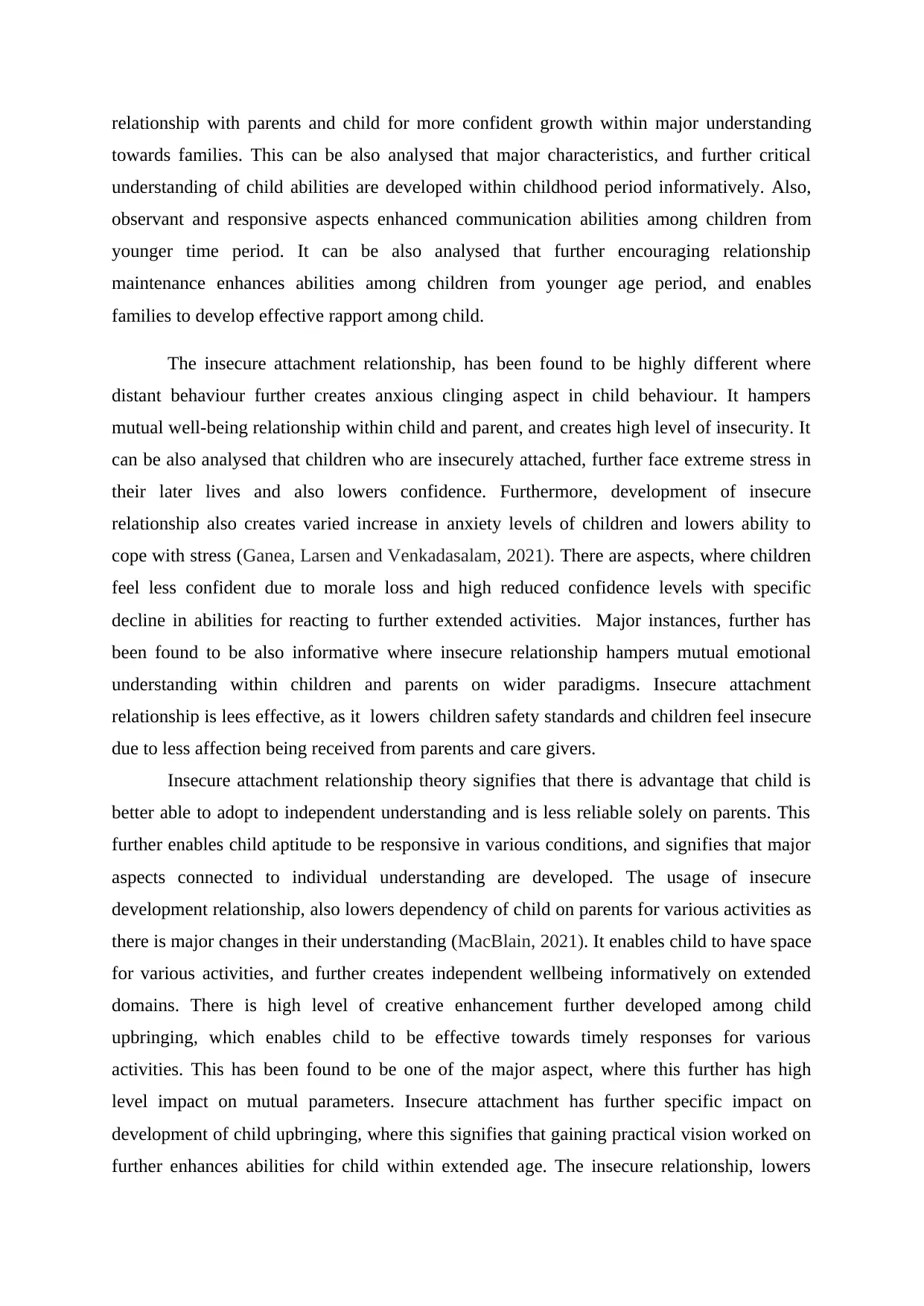
relationship with parents and child for more confident growth within major understanding
towards families. This can be also analysed that major characteristics, and further critical
understanding of child abilities are developed within childhood period informatively. Also,
observant and responsive aspects enhanced communication abilities among children from
younger time period. It can be also analysed that further encouraging relationship
maintenance enhances abilities among children from younger age period, and enables
families to develop effective rapport among child.
The insecure attachment relationship, has been found to be highly different where
distant behaviour further creates anxious clinging aspect in child behaviour. It hampers
mutual well-being relationship within child and parent, and creates high level of insecurity. It
can be also analysed that children who are insecurely attached, further face extreme stress in
their later lives and also lowers confidence. Furthermore, development of insecure
relationship also creates varied increase in anxiety levels of children and lowers ability to
cope with stress (Ganea, Larsen and Venkadasalam, 2021). There are aspects, where children
feel less confident due to morale loss and high reduced confidence levels with specific
decline in abilities for reacting to further extended activities. Major instances, further has
been found to be also informative where insecure relationship hampers mutual emotional
understanding within children and parents on wider paradigms. Insecure attachment
relationship is lees effective, as it lowers children safety standards and children feel insecure
due to less affection being received from parents and care givers.
Insecure attachment relationship theory signifies that there is advantage that child is
better able to adopt to independent understanding and is less reliable solely on parents. This
further enables child aptitude to be responsive in various conditions, and signifies that major
aspects connected to individual understanding are developed. The usage of insecure
development relationship, also lowers dependency of child on parents for various activities as
there is major changes in their understanding (MacBlain, 2021). It enables child to have space
for various activities, and further creates independent wellbeing informatively on extended
domains. There is high level of creative enhancement further developed among child
upbringing, which enables child to be effective towards timely responses for various
activities. This has been found to be one of the major aspect, where this further has high
level impact on mutual parameters. Insecure attachment has further specific impact on
development of child upbringing, where this signifies that gaining practical vision worked on
further enhances abilities for child within extended age. The insecure relationship, lowers
towards families. This can be also analysed that major characteristics, and further critical
understanding of child abilities are developed within childhood period informatively. Also,
observant and responsive aspects enhanced communication abilities among children from
younger time period. It can be also analysed that further encouraging relationship
maintenance enhances abilities among children from younger age period, and enables
families to develop effective rapport among child.
The insecure attachment relationship, has been found to be highly different where
distant behaviour further creates anxious clinging aspect in child behaviour. It hampers
mutual well-being relationship within child and parent, and creates high level of insecurity. It
can be also analysed that children who are insecurely attached, further face extreme stress in
their later lives and also lowers confidence. Furthermore, development of insecure
relationship also creates varied increase in anxiety levels of children and lowers ability to
cope with stress (Ganea, Larsen and Venkadasalam, 2021). There are aspects, where children
feel less confident due to morale loss and high reduced confidence levels with specific
decline in abilities for reacting to further extended activities. Major instances, further has
been found to be also informative where insecure relationship hampers mutual emotional
understanding within children and parents on wider paradigms. Insecure attachment
relationship is lees effective, as it lowers children safety standards and children feel insecure
due to less affection being received from parents and care givers.
Insecure attachment relationship theory signifies that there is advantage that child is
better able to adopt to independent understanding and is less reliable solely on parents. This
further enables child aptitude to be responsive in various conditions, and signifies that major
aspects connected to individual understanding are developed. The usage of insecure
development relationship, also lowers dependency of child on parents for various activities as
there is major changes in their understanding (MacBlain, 2021). It enables child to have space
for various activities, and further creates independent wellbeing informatively on extended
domains. There is high level of creative enhancement further developed among child
upbringing, which enables child to be effective towards timely responses for various
activities. This has been found to be one of the major aspect, where this further has high
level impact on mutual parameters. Insecure attachment has further specific impact on
development of child upbringing, where this signifies that gaining practical vision worked on
further enhances abilities for child within extended age. The insecure relationship, lowers
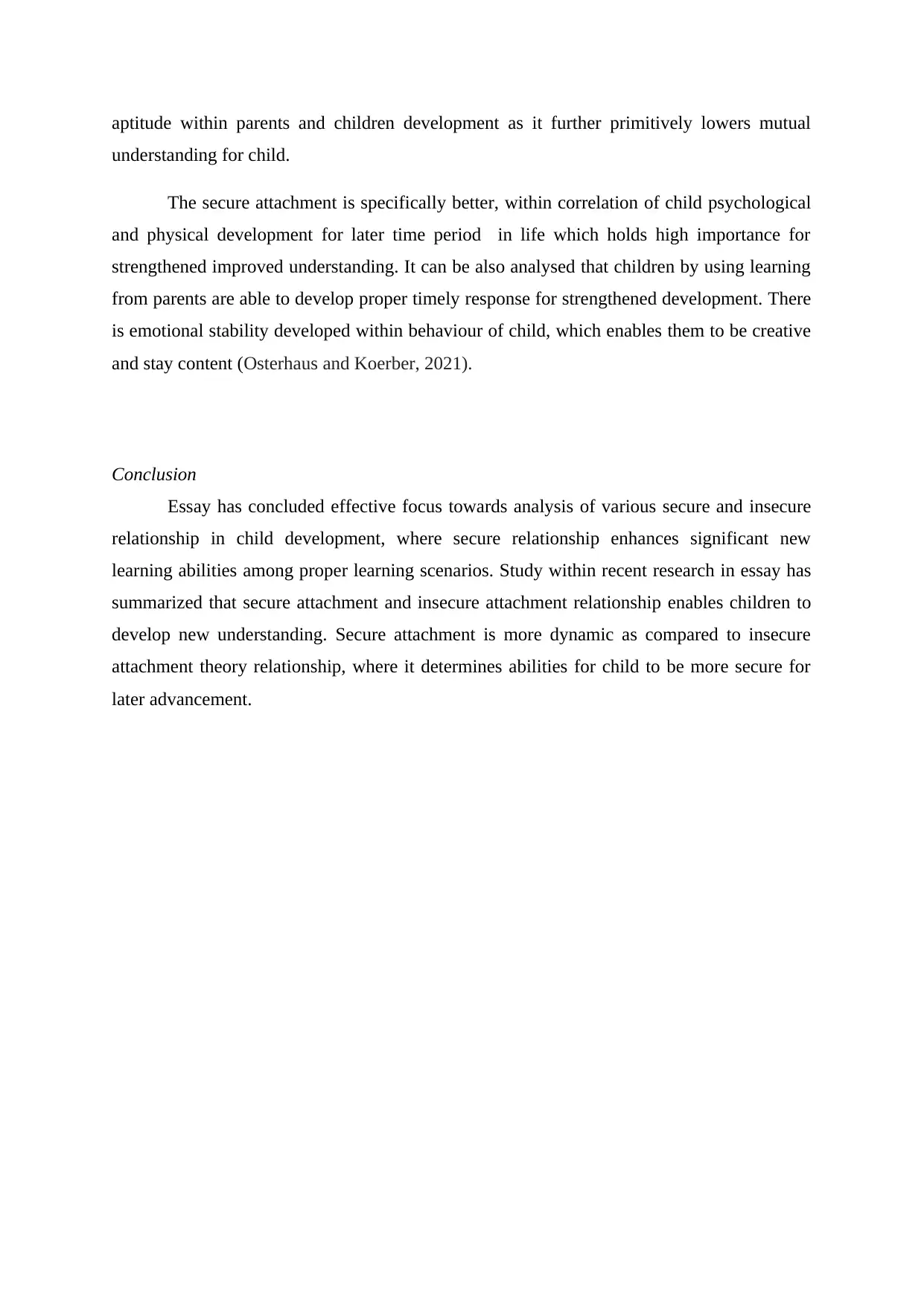
aptitude within parents and children development as it further primitively lowers mutual
understanding for child.
The secure attachment is specifically better, within correlation of child psychological
and physical development for later time period in life which holds high importance for
strengthened improved understanding. It can be also analysed that children by using learning
from parents are able to develop proper timely response for strengthened development. There
is emotional stability developed within behaviour of child, which enables them to be creative
and stay content (Osterhaus and Koerber, 2021).
Conclusion
Essay has concluded effective focus towards analysis of various secure and insecure
relationship in child development, where secure relationship enhances significant new
learning abilities among proper learning scenarios. Study within recent research in essay has
summarized that secure attachment and insecure attachment relationship enables children to
develop new understanding. Secure attachment is more dynamic as compared to insecure
attachment theory relationship, where it determines abilities for child to be more secure for
later advancement.
understanding for child.
The secure attachment is specifically better, within correlation of child psychological
and physical development for later time period in life which holds high importance for
strengthened improved understanding. It can be also analysed that children by using learning
from parents are able to develop proper timely response for strengthened development. There
is emotional stability developed within behaviour of child, which enables them to be creative
and stay content (Osterhaus and Koerber, 2021).
Conclusion
Essay has concluded effective focus towards analysis of various secure and insecure
relationship in child development, where secure relationship enhances significant new
learning abilities among proper learning scenarios. Study within recent research in essay has
summarized that secure attachment and insecure attachment relationship enables children to
develop new understanding. Secure attachment is more dynamic as compared to insecure
attachment theory relationship, where it determines abilities for child to be more secure for
later advancement.
⊘ This is a preview!⊘
Do you want full access?
Subscribe today to unlock all pages.

Trusted by 1+ million students worldwide

REFRENCES
Books and Journals
Cantor, P.,and et.al,., 2021. Whole-Child Development, Learning, and Thriving: A Dynamic
Systems Approach. Cambridge University Press.
Ganea, P. A., Larsen, N. E. and Venkadasalam, V. P., 2021. The role of alternative theories
and anomalous evidence in children’s scientific belief revision. Child
Development, 92(3), pp.1137-1153.
MacBlain, S., 2021. Learning theories for early years practice. Sage.
Osterhaus, C. and Koerber, S., 2021. Social cognition during and after kindergarten: The
relations between first-order and advanced theories of mind. European
Journal of Developmental Psychology, 18(4), pp.573-592.
Saracho, O. N. and Evans, R., 2021. Theorists and their developmental theories. Early Child
Development and Care, 191(7-8), pp.993-1001.
Saracho, O.N., 2021. Theories of Child Development and Their Impact on Early Childhood
Education and Care. Early Childhood Education Journal, pp.1-16.
Scirocco, A. and Recchia, H., 2021. Context specificity in adolescents’ implicit theories of
morality. Cognitive Development, 60, p.101112.
Books and Journals
Cantor, P.,and et.al,., 2021. Whole-Child Development, Learning, and Thriving: A Dynamic
Systems Approach. Cambridge University Press.
Ganea, P. A., Larsen, N. E. and Venkadasalam, V. P., 2021. The role of alternative theories
and anomalous evidence in children’s scientific belief revision. Child
Development, 92(3), pp.1137-1153.
MacBlain, S., 2021. Learning theories for early years practice. Sage.
Osterhaus, C. and Koerber, S., 2021. Social cognition during and after kindergarten: The
relations between first-order and advanced theories of mind. European
Journal of Developmental Psychology, 18(4), pp.573-592.
Saracho, O. N. and Evans, R., 2021. Theorists and their developmental theories. Early Child
Development and Care, 191(7-8), pp.993-1001.
Saracho, O.N., 2021. Theories of Child Development and Their Impact on Early Childhood
Education and Care. Early Childhood Education Journal, pp.1-16.
Scirocco, A. and Recchia, H., 2021. Context specificity in adolescents’ implicit theories of
morality. Cognitive Development, 60, p.101112.
1 out of 7